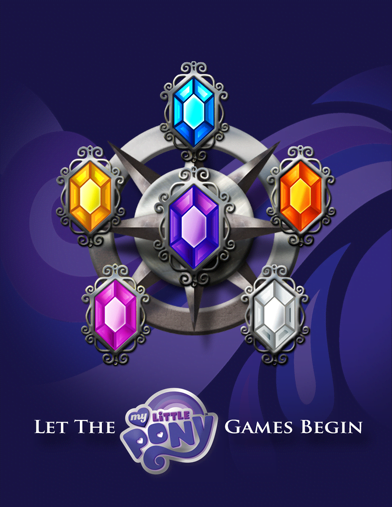Hello and welcome to 2014, fellow dice lobbers! I hope you all had a fantastic holiday season. I personally scored several delightful new games that I’m excited to share with you all over the next few weeks, but one of them stands above the rest. On December 13th, 2013 Enterplay released the My Little Pony: Collectible Card Game. Seeing as how My Little Pony: Friendship is Magic is such a hot property right now, this comes as no real surprise and since I’m a bit of a brony myself I was eager to see how it played. After skirmishing a bit with the starter decks and taking part in a few organized play events, I am happy to report that this game is just plain fun!
Components
Being a card game, there’s not much to say about the components for My Little Pony. The cards are a good quality standard card stock and the layout is easy to read and understand – for the most part. I have noticed some confusion in new players (myself included) over the numbers that indicate a card’s cost to bring it into play versus a card’s strength value. I don’t think this is a flaw, though. Parsing out the information on the cards just takes some practice like any other game.
I particularly like the variety of artwork used for the cards. Almost all of it comes from screenshots of the show and they really reach out into all sorts of different scenes and characters to create a diverse card pool. In addition, some of the flavor text will have fans of the show chuckling to themselves.
Rules & Gameplay
Given the source material, it’s easy to understand that MLP is not a game about direct conflict. Unlike Magic or Pokemon, you won’t be pitting your characters against one another in mortal combat. Instead, each player has 2 decks – a play deck and a smaller problem deck. During set-up, each player will find a starting problem in their problem deck and flip it face up. By playing characters to these problems, players will accrue points. The first player to 15 points wins the game.
As simple as that sounds, there is a surprising amount of depth here. Players can play their characters to either their own problem deck or their opponents. Each problem also has different conditions that must be met in order to “confront” it and gain points. Normally, these requirements revolve around having a certain amount of power from one type of character and a certain amount of power from a different type of character. The types revolve around each of the main characters from the show – Twilight Sparkle, Rainbow Dash, Pinkie Pie, Fluttershy, Applejack and (my favorite) Rarity. I don’t want to get to deep into the whole deck construction and meta-game side of the game, though. The core idea is what’s important and that is simply that you will have multiple types of characters at your disposal to solve these problems.
In addition to characters, players will also be able to play one time events to boost their own cards or hinder their opponent in some way. There are also resources which will attach themselves to characters or zones of play to enhance or diminish them in some way. Troublemaker cards can also be played to make problems harder to solve. Overall, there’s a lot going on! Luckily, the rulebook is laid out well and is easy to read. All the basic concepts are covered and ought to be enough to get people started. Unfortunately, the rulebook is not particularly helpful when players need to clarify a rule or determine the order of operation for certain special abilites. So far, it has fallen to the community to discover such rulings. This is not uncommon with card games, however and shouldn’t be a deciding factor in whether or not you want to invest in the game.
Final Thoughts
The MLP card game is a lot of fun to play for both fans and non-fans alike. The rules are easy to learn and Enterplay has released a number of starter decks that are well suited for casual play. The game is also very rewarding for more hardcore gamers who want a deep card game with a lot of important choices and options. I’m not terribly fond of the distribution method; random booster packs help encourage a robust environment for trading, but are not helpful for casual gamers or new players. However, given how popular the game is already, most new/causal players shouldn’t have a problem finding someone willing to lend a helping hand, err… hoof.


